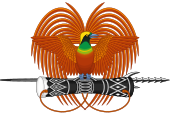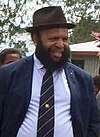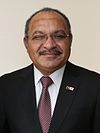Prime Minister of Papua New Guinea
| Prime Minister of the Independent State of Papua New Guinea | |
|---|---|
| Praim Minista bilong Papua Niugini (Tok Pisin) | |
 | |
 | |
since 30 May 2019 | |
| Style | The Honourable |
| Status | Head of Government |
| Abbreviation | PM |
| Member of | |
| Seat | Port Moresby |
| Appointer | Governor-General |
| Term length | At the Governor-General's pleasure |
| Precursor | Chief Minister of Papua and New Guinea |
| Inaugural holder | Michael Somare |
| Formation | 16 September 1975 |
| Deputy | Deputy Prime Minister of Papua New Guinea |
| Salary | PGK346,037/US$ 97,201 annually (2015)[a][1] |
| Website | https://pmnec.gov.pg/ |
 |
|---|
|
|
The prime minister of the Independent State of Papua New Guinea (Tok Pisin: Prai Minista bilong Papua Niugini) is Papua New Guinea's head of government, consequent on being the leader of the party or coalition with majority support in the National Parliament. The prime minister serves as the head of his party, the head of the coalition government, and the chairman of the National Executive Council.
History
[edit]The office of Prime Minister was preceded by the Chief Minister.
2011–2012 constitutional crisis
[edit]From December 2011, the office was disputed between Peter O'Neill of the People's National Congress Party and Sir Michael Somare of the National Alliance Party; the latter eventually supported O'Neill as Prime Minister on 3 August 2012, thus ending the constitutional crisis.
Department of the Prime Minister
[edit]The Department of the Prime Minister has the task of providing administrative services to the restoration exercise as well as advising the Prime Minister and other government leaders. After a July 1995 cabinet reshuffle by Julius Chan, functions of the department were expanded.[2]
Office
[edit]The office of the prime minister and other key government offices were initially located in Konedobu before being relocated to Waigani shortly after independence in 1975. Since April 2024, the Prime Minister's Office has been located at the newly-constructed Melanesia Haus, located opposite the main entrance to the National Parliament House.[3][4]
List of prime ministers of Papua New Guinea (1975–present)
[edit]- Political parties
- Status
| No. | Portrait | Name (Birth–Death) |
Election | Term of office | Political party | ||
|---|---|---|---|---|---|---|---|
| Took office | Left office | Time in office | |||||
| 1 | 
|
Michael Somare (1936–2021) |
1977 | 16 September 1975 | 11 March 1980 | 4 years, 177 days | Pangu[5][6][7] |
| 2 | 
|
Sir Julius Chan (born 1939) |
— | 11 March 1980 | 2 August 1982 | 2 years, 144 days | PPP[5][6] |
| (1) | 
|
Michael Somare (1936–2021) |
1982 | 2 August 1982 | 21 November 1985 | 3 years, 111 days | Pangu[5][6][7] |
| 3 | 
|
Paias Wingti (born 1951) |
1987 | 21 November 1985 | 4 July 1988 | 2 years, 226 days | PDM[5][6] |
| 4 | 
|
Sir Rabbie Namaliu (1947–2023) |
— | 4 July 1988 | 17 July 1992 | 4 years, 13 days | Pangu[5][6] |
| (3) | 
|
Paias Wingti (born 1951) |
1992 | 17 July 1992 | 30 August 1994 | 2 years, 44 days | PDM[6] |
| (2) | 
|
Sir Julius Chan (born 1939) |
— | 30 August 1994 | 27 March 1997 | 2 years, 209 days | PPP[6][7] |
| 5 | 
|
John Giheno (1949–2017) |
— | 27 March 1997 | 2 June 1997 | 67 days | PPP |
| (2) | 
|
Sir Julius Chan (born 1939) |
— | 2 June 1997 | 22 July 1997 | 50 days | PPP[6][7] |
| 6 | 
|
Bill Skate (1953–2006) |
1997 | 22 July 1997 | 14 July 1999 | 1 year, 357 days | PNC[6][7] |
| 7 | 
|
Sir Mekere Morauta (1946–2020) |
— | 14 July 1999 | 5 August 2002 | 3 years, 22 days | PDM[7] |
| (1) | 
|
Sir Michael Somare (1936–2021) |
2002 2007 |
5 August 2002 | 4 April 2011 | 8 years, 362 days | NAP[5] |
| — | 
|
Sam Abal (born 1958) Acting prime minister |
— | 13 December 2010 | 17 January 2011 | 35 days | NAP[5] |
| — | 4 April 2011 | 2 August 2011 | 120 days | ||||
| 8 | 
|
Peter O'Neill (born 1965) |
2012 2017 |
2 August 2011 | 29 May 2019 | 7 years, 300 days | PNC |
| 9 | 
|
James Marape (born 1971) |
2022 | 30 May 2019 | Incumbent | 5 years, 170 days | Pangu |
See also
[edit]Notes
[edit]References
[edit]- ^ "Salaries and Remuneration Commission – Determinations – 2015" (PDF). parliament.gov.pg. Papua New Guinea National Parliament. 15 January 2015.
- ^ "Department of Prime Minister and NEC". Destination PNG. Retrieved 4 January 2023.
- ^ "PM's office relocated to Melanesia Haus". The National. Retrieved 17 April 2024.
- ^ "PM opens Melanesia Haus". Papua New Guinea Post-Courier. Retrieved 17 April 2024.
- ^ a b c d e f g "Background Note: Papua New Guinea". US State Department. April 2007. Retrieved 14 August 2007.
- ^ a b c d e f g h i Dorney, Sean (2001). Papua New Guinea: people, politics and history since 1975. ABC Books. ISBN 0-7333-0945-3.
- ^ a b c d e f May, R.J. (2001). State and society in Papua New Guinea: the first twenty five years. Crawford House Publishing. ISBN 1-86333-204-9.


